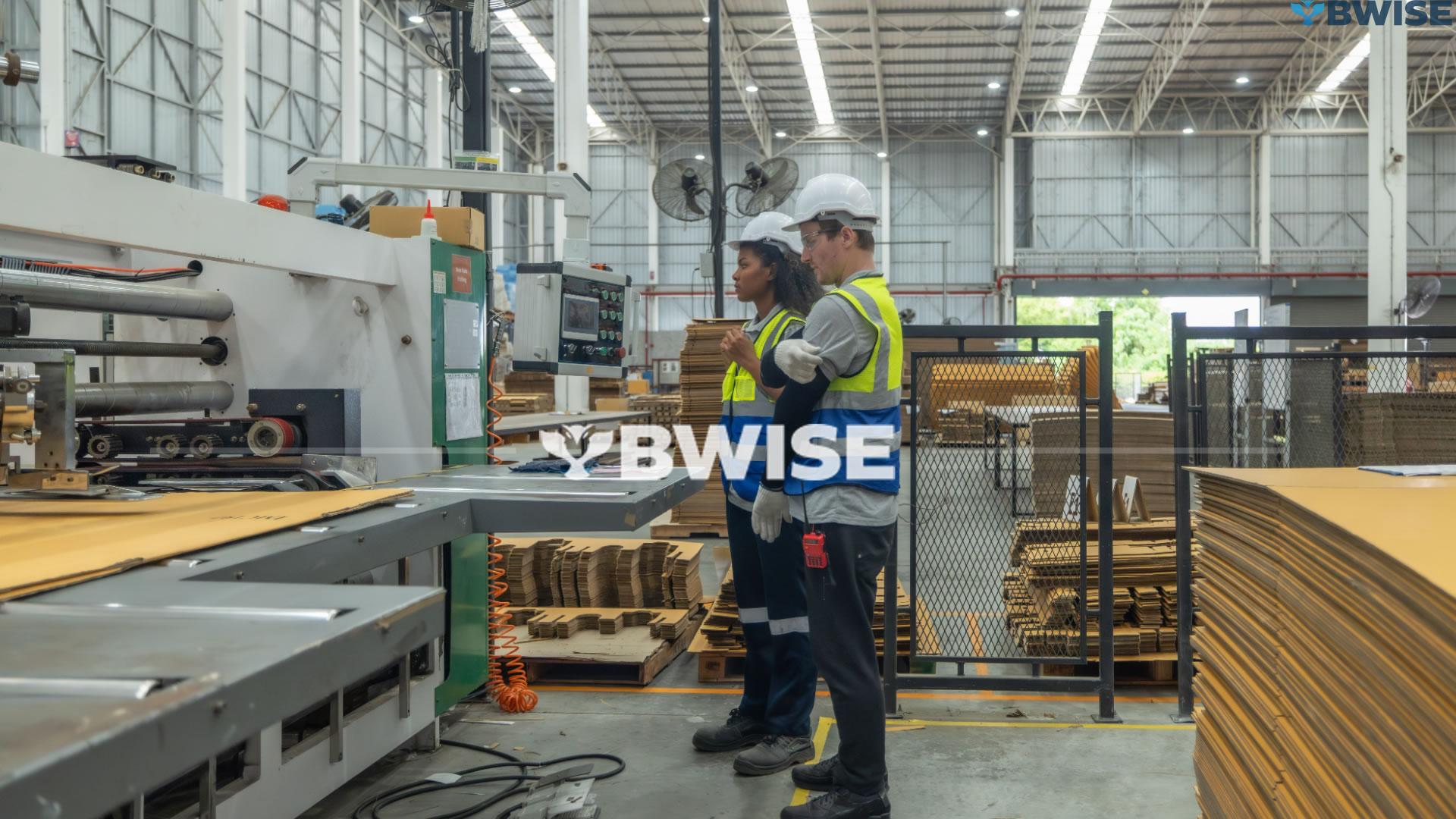In today’s rapid business environment, firms constantly seek to streamline their processes. They focus on eliminating waste and boosting revenues. Lean manufacturing principles provide a handy tool to meet these goals. These methods have transformed the operations of leading global enterprises in the fields of production and logistics.
Let us dive into the primary lean manufacturing techniques. These techniques can elevate your business efficiency, profits, and happiness of your customers. You will get to know about lean thought processes, plans, and gear for continued enhancement. This unveils the process to use these powerful methods in your manufacturing environment.

Key Takeaways
- Lean manufacturing is a systematic approach to identifying and eliminating waste in production processes.
- Continuous improvement, just-in-time production, and Kaizen are core lean principles that drive operational excellence.
- Value stream mapping, 5S methodology, and total productive maintenance are key lean tools for visualizing workflows and maximizing uptime.
- Implementing lean manufacturing can significantly reduce costs, improve quality, and enhance customer satisfaction.
- Adopting a lean mindset requires a cultural transformation and ongoing commitment to process improvement.
Lean Manufacturing Methods: A Primer
In the sphere of production, the approach of leaning has vast importance. It enables smarter work, reducing unnecessary elements, and elevating profits. The concept of lean manufacturing is enveloped around constant improvement. It aims to eradicate waste and improve operations. As a result, businesses can increase production and create a competitive edge.
What Is Lean Manufacturing?
Lean manufacturing focuses on creating more while using less. It is a concept that originated in post-World War II Japan. The goal is simple: Make the best possible goods or provide the finest services using minimal effort and resources.
Principles of Lean Manufacturing
Lean manufacturing is built on a few key ideas. These ideas help put lean into action. They include:
- Continuous improvement: Always looking for ways to make things better and cut waste.
- Waste elimination: Getting rid of the seven deadly wastes in making things, like making too much, moving things around, and having too much stock.
- Just-in-time production: Making things only when customers want them to cut down on stock and make the supply chain smoother.
- Empowered and engaged workforce: Getting employees involved in making things better and using their skills.
- Standardized work: Having clear, documented ways of doing things to keep quality and efficiency up.
By following these ideas, companies can really benefit from lean manufacturing. They will see more profit, happier customers, and a business that is better for the future.
Continuous Improvement: The Cornerstone of Lean Manufacturing
The principle of lean manufacturing revolves around ‘Kaizen’ or the commitment to constant enhancement. With a spotlight on incremental daily adjustments, it refines operations. Its power lies in eliminating wasteful elements and ushering innovative thoughts into the discussion. Hence, firms evolve to work swifter, output more, and increase profits.
Improvement is an ongoing mission, not just a band-aid solution. Everyone, from the crew members right up to the company captains, contributes. United, they search out and mend sections that could use a boost. Regular get-togethers and idea sharing sessions aim to slash waste, trim expenses, and uplift customer spirits.

You must be ready for change and have a sturdy plan to successfully run a continuous improvement program. It is all about clarity of aims, equipping workers with decision making abilities, and providing them necessary resources. Remember, even the tiny triumphs matter big time. In this process, businesses can reach enhanced efficiency and success.
Getting better is what lean manufacturing is all about. It is about growth. When companies take this on, they can keep up with the changes, meet what the market wants, and win overall.
Waste Elimination: The Key to Profitability
Lean manufacturing works to remove waste. This is critical for increasing profits and enhancing operations. Companies inspect each production process in detail. The goal is to discover improved methods to boost productivity and profit margins.
Seven Deadly Wastes in Manufacturing
Let us chat about the seven big no-nos when we make stuff: overdoing it, hauling things here and there, hoarding supplies, excessive movement, idle time, too much effort, and slip-ups. Imagine making more goodies than folks crave; you end up with a surplus and squandered goods. Shifting things willy-nilly becomes a senseless drain. Overstocking? That is just excessive raw materials, half-baked projects, and unused finished products.
Unnecessary actions by employees lead to wasted motion. Waiting unfolds when production halts due to hold-ups. Over-processing occurs when too many steps are taken in manufacturing. Fixing or ditching defective goods depletes time and resources.
Identifying and Eliminating Waste
Getting rid of waste needs careful observation and record-keeping. Sketch out how items are made. This way, businesses can spot where waste occurs and think of solutions. This could mean improving workspace, applying on-demand inventory, or using visual aids to organize.
Working together and always looking to improve, companies can get rid of the seven deadly wastes. This leads to more profit.
Just-in-Time Production: Streamlining Inventory
Success in manufacturing hinges on efficiency. The introduction of just-in-time (JIT) production has been a game-changer. This lean method curbs waste by only producing what’s required, precisely when it is required.
Benefits of Just-in-Time Manufacturing
Using just-in-time production has many rewards. It cuts down on storage costs and frees up space. This makes companies more flexible and quicker to respond to what customers want.
It also helps keep quality high. If a part is faulty, it gets fixed right away. This stops bad parts from causing more problems later.
“Just-in-time” production method is awesome. It cuts down delivery periods. Synchronizing material flow with production gets products to customers quicker. Delighted customers and trendy products are more achievable now!
The concept of just-in-time production can revolutionize the way manufacturers operate. It improves inventory management and reduces unnecessary elements. Such strategies can enhance productivity, boost earnings, and solidify competitiveness in the market.
Kaizen: The Art of Continuous Improvement
Kaizen, rooted in Japan’s lean manufacturing, highlights gradual, consistent adjustments to enhance operations. Such minute alterations may boost an institution’s performance and outcomes. Utilizing kaizen allows companies to optimize efficiency, reduce excess, and increase profits.
Within a business, all team members from employees to executives should continuously seek improvement. This could involve tweaking processes, maximizing the use of tools, or smartening inventory management. The objective is constant evolution and learning, rather than clinging to old ways.
Kaizen can be applied in numerous methods. For example, frequent brainstorming and utilizing tools such as the Plan-Do-Check-Act (PDCA) cycle. Empowering employees to solve issues taps into the company’s wisdom effectively. Furthermore, it fosters a culture that perpetually seeks enhancement.
Applying kaizen to lean manufacturing offers great advantages. It boosts company flexibility, enhances the quality of products, and increases customer satisfaction. In essence, kaizen is a vital path for embracing lean manufacturing concepts. It aids businesses in gaining an edge in a competitive market.
Value Stream Mapping: Visualizing the Flow
Lean manufacturing revolves around a crucial tool known as value stream mapping. This allows businesses to decode their manufacturing process more efficiently. The method provides a thorough view, from inception to completion, enabling the identification and elimination of waste.
When companies chart their value stream, they can pinpoint areas of delay and inefficiency. Streamlining the value flow results in more streamlined, quicker, and efficient operations. This ramps up profits and delights customers.
Value stream mapping excels in tracing the flow of data and materials in a business. It identifies strategies to cut down on delays, minimize inventory, and enhance lean manufacturing initiatives.
This simple strategy enables businesses to make informed decisions and boost their output. Efficiency skyrockets, reaction times shrink, and they can really zoom in on customer desires.

5S Methodology: Organizing for Efficiency
The 5S plan is crucial in lean manufacturing. Its aim? A tidy, effective workspace. Born from Japanese manufacturing, it rests on five pillars: Sort, Set in Order, Shine, Standardize, and Sustain. With 5S, a business skyrockets efficiency, trims waste, and smooths operations. Consequently, profits rise.
The Five S’s Explained
The 5S method is an organized approach to make the workspace spotless, orderly, and effective. Let us break down what each of these five S’s signify and their benefit:
Sort (Seiri): Start by going through the space and take away stuff not in use. This action eliminates mess, leaving solely necessary tools and resources.
Set in Order (Seiton): After removing the unnecessary items, arrange what is left in a logical way. This might mean labeling spots, using colors to mark equipment, or setting up a system to easily find things.
Shine (Seiso): Keeping the workplace clean is key to staying efficient. The shine step means cleaning regularly and checking for dirt, debris, or safety risks.
Standardize (Seiketsu): To keep the 5S system going, set up standard ways of doing things. This could be through checklists, training, or visual controls to keep the area organized and efficient over time.
Sustain (Shitsuke): The last step is to keep up the decent work. This means having a culture of discipline where everyone helps keep the 5S system going. They also look for ways to make things better and more organized.
By using the 5S methodology, companies can make their work environment clean, organized, and ready for ongoing improvement. This leads to more productivity, less waste, and better manufacturing performance.
Total Productive Maintenance: Maximizing Uptime
In our bustling manufacturing universe, enhancing machine performance holds the ticket to productivity and profit growth. Total Productive Maintenance (TPM) is a leading game plan for this. It sharpens the function of machinery and establishments, reduces malfunction episodes, and elevates overall equipment efficiency.
TPM is all about making sure machines are in excellent working order before issues arise. With smart planning and anticipating any issues, businesses can sidestep sudden halts and keep their tools hustling steadily. This improves workflow and extends the lifetime of the equipment, which results in cost savings over time.
In a TPM environment, businesses foster a sense where equipment care is everyone’s job. Folks from all job levels contribute to keeping their gear dependable, promoting a collaborative feel. This team unity aids in identifying and resolving the actual causes of equipment breakdowns, curtailing idle time.
Adding TPM to a lean manufacturing plan brings big benefits. It means more time running, lower maintenance costs, and better products. For companies aiming to lead, mastering TPM can change the game, pushing them to new heights of success and profits.
Lean Manufacturing Methods: Kanban and Poka-Yoke
Kanban and Poka-Yoke are important when it comes to making lean manufacturing work. Kanban takes care of how materials move around. It makes sure you make the right amount and get it where it needs to go, when it needs to get there. This way, there’s less waste, you’ve got just the right amount of stock, and things run more smoothly.
Poka-Yoke is a method that stops errors before they happen. It employs unique tools to identify and halt mistakes, guaranteeing top-notch products. So, businesses using this experience less redoing of tasks and boosts customer happiness.
Kanban and Poka-Yoke stand strong as exceptional tools in lean manufacturing. Their roles are to aid businesses in improving productivity, cutting down unnecessary wastes, and enhancing profit margins. Mastery and application of these techniques are vital to thrive in a lean operational environment.
